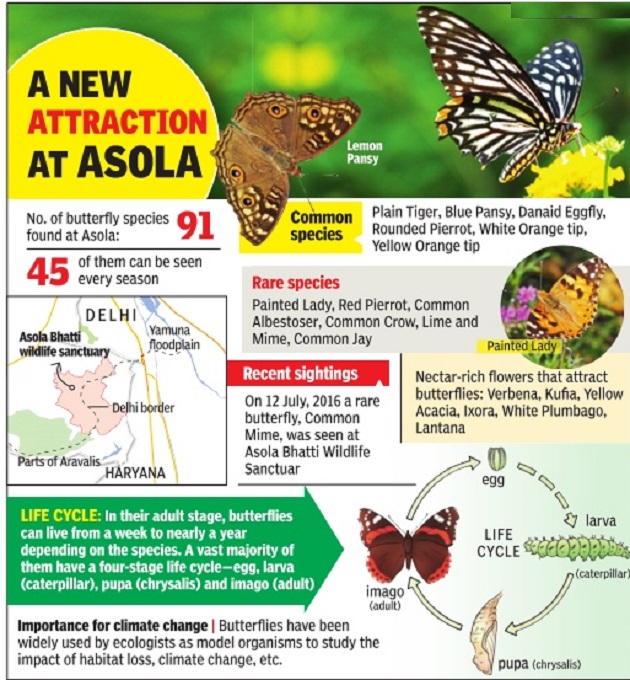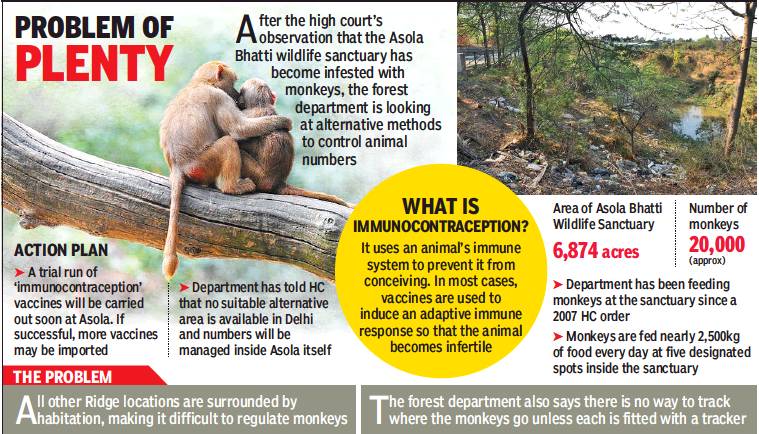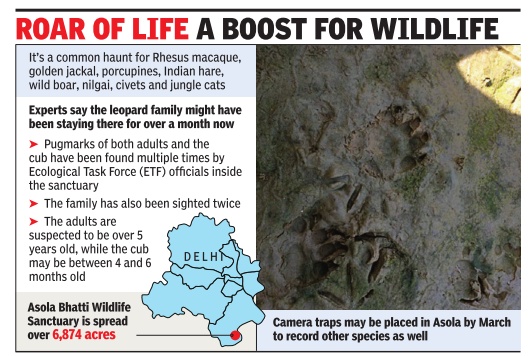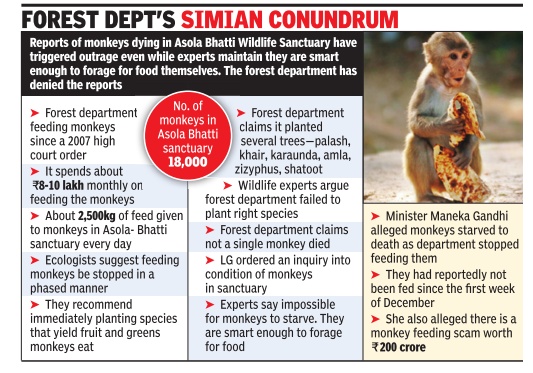Asola Bhatti Wildlife Sanctuary (Delhi/ Haryana)
Note: The Asola Bhatti Wildlife Sanctuary is in Delhi as well as Haryana

Sohail Madan/ Jasjeev Gandhiok, The Times of India
This is a collection of articles archived for the excellence of their content. |
Contents[hide] |
Area under the sanctuary
2016: Buffer zone proposed
The Times of India, Apr 22 2016

Haryana creates Asola buffer zone
Bagish Jha
Proposes 100m Radius Around Sanctuary In Gurgaon, 1km In Faridabad The Haryana government has forwarded the final draft of the demarcation of the eco-sensitive zone (ESZ) on its side of Asola Bhatti wildlife sanctuary for approval to Union ministry of environment, forests and climate change (MoEFCC). The state government had proposed a 100m radius around the boundary of the sanctuary as the ESZ in Gurgaon, and a 1km radius around it in Faridabad.
The ESZ details were released in a reply to an RTI filed by advocate Sanjeev Aliawadi in January 2016.
To protect developers from ESZ regulations, the state has recommended excluding areas for which change of land use (CLU) has already been granted for residential and commercial projects, and where projects are on-going.“In the absence of a notified ESZ, a 10 km-radius ESZ is applicable, in line with the 2006 Supreme Court order. But that will affect developmental work already underway ,“ read the final ESZ proposal sent to MoEFCC. On behalf of the state government, it was submitted by P P Bhojvaid, the state's additional principal chief conservator of forest and chi ef wildlife warden (CWW).
The demarcation of ESZ was initiated after a December 4, 2006 Supreme Court direction to all states, over a PIL filed by Goa Foundation, asking them to declare ESZs around protected areas. Based on this, MoEFCC issued a guideline on how ESZs could be demar cated, on February 9, 2011.
Spread over 32.71 sq km along south-eastern Delhi bordering Gurgaon and Faridabad in Haryana, Asola Bhatti is the only protected area in the National Capital Territory (NCT). The Asola Bhatti ESZ includes parts of Gwalpahari, Balola, Bandhwari and Kha rak in Gurgaon district, and Mangar, Gothra, Mohabbatabad, Pali, Bhankri, Anangpur, Ankhir, Meola Maharajpur, Surajkund and Badkhal in Faridabad district.
On June 20, 2015, the Haryana CWW had constituted a committee, consisting of Gurgaon's divisional wildlife and forest officers, and the deputy conservator of forest in Faridabad, to suggest the extent of ESZ on the Haryana side. The committee submitted its report in October 2015, recommending a kilometre of ESZ along the sanctuary boundary .
At a meeting to demarcate the ESZ in December 2015, chaired by principal secretary of forests Amit Jha, the deputy commissioners of Gurgaon and Faridabad, along with the Haryana director general of mines and geology and the department of town and country planning (DTCP), together submitted their objections to the suggestion of a kilometrewide area as ESZ.
DTCP suggested that those areas in Gwalpahari and Faridabad that can be urbanised, and areas for which licenses to develop residential and commercial complexes have already been given, be exempted and kept outside the ESZ.
The Gurgaon deputy commissioner said the ESZ should not be over 100m from the sanctuary boundary .
“The 100m area is where there is no existing road or physical structure,“ said deputy commissioner T L Satyaprakash. For Faridabad, it was proposed that the ESZ be restricted to 1km from the boundary .
2017: 1-km buffer zone granted
Jasjeev Gandhiok, Asola Bhatti sanctuary gets 1-km buffer zone, Sep 20, 2017: The Times of India
Asola Bhatti Wildlife Sanctuary has got a buffer zone and ecological protection following a recent notification by the Union environment and forest ministry that has declared a onekilometre eco-sensitive zone around the wildlife sanctuary to protect its flora and fauna.
The notification, which prohibits construction or industrial activities in the sensitive zone, has directed the Delhi government to prepare a zonal action plan within two years for the zone and on how to regulate activities there.
The notofication follows a 2011 Supreme Court order that directed all states to declare such buffer zones. In this case, the Delhi government will draft the plan in consultation with the Haryana government as parts of this 15.55sq-km eco-sensitive zone also falls under Haryana. The government will also have to consult local people.
The notification says, “It is necessary to conserve and protect the area...from ecological, environmental and biodiversity point of view and prohibit industries or class of industries and their operations and processes“ in this zone. The fauna in the area is represented by 17 species of mammals, around 201species of resident and migratory birds, 12 species of reptiles and five species of amphibians, including nilgai, jungle cats, small Indian civet, mongoose, jackal and porcupine, it added. The sanctuary also has 83 species of trees, 30 species of shrubs, 95 species of herbs and about 18 species of grasses.
The zonal plan, which will have to be ready within two years from the date of publication of the notification, will include steps for groundwater management, soil and moisture conservation and demarcate existing worshipping places, villages and urban settlements. It, however, cannot impose any restriction on the approved and existing land use, infrastructure and activities.
Activities like setting up of industries, commercial mining, establishment of waste disposal sites or poultry farms will be prohibited in the eco-sensitive zone, while activities like eco-tourism and introduction of exotic species will be regulated under the laws.
Welcoming the move, experts said it would stop construction activities in the area.“A lot of construction had affected the stormwater drains opening into the lakes,“ said Sohail Madan, centre manager at Conservation Education Centre at Asola. “It is a positive move and will help protect the animal corridors in the sanctuary ,“ he added.
The animals
Butterfly park
Jun 06 2017: Chase butterflies at Delhi's newest park, The Times of India

While inaugurating the park, development minister Gopal Rai and environment minister Imran Hussain encouraged Delhiites to plant trees in their localities.
The environment department's Delhi Parks and Gardens Society has been given the task of maintaining and developing green patches around the capital, and assisting anyone willing to plant trees. The saplings given by the department are free of cost, environment minister Imran Hussain said. “We are trying to make Delhi green and every individual can help us in that by planting trees in their neighbourhood,“ he added.
Development minister Gopal Rai, who had earlier launched several Car-Free Day events in the capital, said pollution levels have go ne up so much that it has become extremely important to take care of the environment. The minister also spoke about how Sweden was in a similar situation but came out of it because of the collective efforts of its citizens.
The new butterfly park is part of the eco-tourism plan of the environment and forest department, with focus on developing the sanctuary and improving the habitat of species found there, forest officials say.
“Butterflies and other insects form the lower strand of the food chain. If we can protect these butterflies, we can actually protect the other species placed higher in the chain. We believe in building a chain of conservation,“ said Sohail Madan, project manager and centre head of Bombay Natural History Society .
Officials said 64 species of butterfly have already been spotted on the campus and the number will grow with more development inside.
Hyena
The Times of India, Jul 12 2015

Asola-Bhatti can be NCR's hyena habitat
Delhi's depleting scrub forests and the Aravalis around it may be home to the threatened striped hyena.While the forest department believes there may be a fairly healthy population, they will confirm it by camera trapping in a couple of months.
Hyenas may not be as charismatic as the tiger or leopard but, if nurtured, Delhi's Asola Bhatti Sanctuary can be made to stand out as a habitat for the animal. The department had conducted a camera trapping exercise way back in 2000 and officials claim a pack was seen often in those days.
There is no dearth of prey or food for hyenas in the sanctuary . Experts say they can thrive on dead cattle, dead dogs or monkeys or even hunt for food. There is a dumping ground for dead animals near the Haryana border, too, which hyenas may be foraging on.
A book, “An Introduction to Delhi Ridge”, edited by G N Sinha, former additional principal chief conservator of forests, mentions “a pack of striped hyenas is also spotted occasionally in the Bhatti area“.
Asola Bhatti sanctuary is a small area of 4,707 acres in Maidan Garhi, notified in 1986, and about 2,167 acres in Bhatti, notified in 1991. But it shares a border with the Faridabad frontier of the Aravalis, making it an important wildlife corridor. The department is in talks with the Haryana government to secure an eco-sensitive zone shared between the two states.
Monkeys
Jan 05 2015
Asola monkeys must be weaned off feed: Experts
The forest department in Delhi spends most of its funds not on protecting endangered species or on reviving the leopard populationbut on feeding monkeys. It's a perplexing problem, but, following a high court order, the department sends 2,500kg of fruits and vegetables to feed over 18,000 monkeys every day which were moved from the city to Asola Bhatti sanctuary in 2007. The department reportedly stopped feeding monkeys in the wildlife sanctuary for a few days when prices of vegetables and fruits went up but what ensued was more baffling. Many animal lovers claimed monkeys were starving to death. In fear of retaliation, the department resumed feeding them.
But primatologists and wildlife experts say monkeys are too smart to starve. They are extremely adaptable mammals who will leave the sanctuary to forage in neighboring villages or just come back to the city. All the department needs to do is to plant the species that monkeys love and stop feeding them.
“The department should have prepared the sanctuary before releasing monkeys in it. I had given them a list of species, including bansa, gram, banana and sugarcane, but those were not planted. I have seen how much food the department is just wasting on the pretext of feeding mon keys,“ said Iqbal Malik, a veteran primatologist.
Even forest officials jest that the wildlife sanctuary is gradually turning into a Rhesus monkey sanctuary .“There are 18,000 of them. It's not possible to care for so many and they are multiplying exponentially . Sterilization is not being considered because animal rights activists will protest. We have no option but to feed them. None of them are starving. In fact, the problem is that the place has lost its ecological balance. We don't have many predators feeding on monkeys. On the other hand, the carrying capacity of our sanctuary is not suited for such a large monkey population,“ said a senior official. The lieutenant governor recently ordered a probe into whether monkeys were starving in the sanctuary .
CR Babu, DU professor emeritus and chairman of a state-level experts appraisal committee, is also of the view that monkeys should be gradually weaned off the habit of being fed. “There are people who believe feeding birds, monkeys and other animals is a great service. But we are destroying their natural immunity and survival skills. They should forage on their own.That can be done by planting the species they feed on. Why is Pongemia and neem being planted by the department when animals don't eat them?” he said.
Experts say the department can turn the situation around in five years--if they slowly stop food supply and plant the right species.
2018: govt to use special vaccines to cap monkey population

From: Jasjeev Gandhiok, Simian count at Asola Bhatti high, govt to use special vaccines to cap it, April 4, 2018: The Times of India
Delhi’s forest department may soon be trying a host of new techniques to bring the growing monkey population under control across the capital, beginning with special vaccines imported from abroad.
Following Delhi high court’s recent observation that the Asola Bhatti wildlife sanctuary had become extremely overpopulated, the forest department wrote to the Wildlife Institute of India (WII) to import special ‘immunocontraception’ vaccines for a trial run, which will be conducted at the Asola Bhatti sanctuary that currently houses nearly 20,000 monkeys.
Forest officials said discussions were held recently to find an alternative site in the city where the monkeys could be shifted, however no suitable place could be identified. Following this, other options were being discussed. Officials said immunocontraception vaccines have been used abroad successfully and are often used in the wildlife to control the numbers of several different species.
“The vaccine is quite expensive and will have to be imported to the capital, so we will first use it on a trial basis before importing more. The trials will be carried out at the Asola Bhatti wildlife sanctuary soon,” a forest official told TOI.
According to sources, the monkeys will be isolated in the testing phase and examined for a brief period to see how effective the technique can be. Based on the success of it, the department will take the next call. “Finding new locations is a problem as the central or northern ridge both have settlements around them. If monkeys are released there, they will start moving out and reach colonies nearby,” said a forest official.
Experts, however, feel natural options in the form of predators need to be looked at. C R Babu, professor emeritus and head of the Centre for Environmental Management of Degraded Ecosystem (CEMDE), said the department needs to improve the habitat at Asola so that the predator count increases in the area. “Once you improve the habitat, the carnivores and predators will increase and this will naturally control the population of monkeys there. Civet cats and jackals are already known to prey on young monkeys and an increase in their numbers can help bring better balance,” he added.
The forest department has been transferring monkeys to Asola Bhatti wildlife sanctuary for nearly a decade now after a high court order. The monkeys are fed nearly 2,500kg food every day.
Jan 2018/ ₹8lakh a month spent to feed simians
Jasjeev Gandhiok, January 18, 2018: The Times of India

From: Jasjeev Gandhiok, January 18, 2018: The Times of India
See graphic:
The issue of monkeys at Asola Bhatti Wildlife Sanctuary in 2018, and the differing High Court orders of 2007 and 2018
Asola sanctuary spends ₹8L/mth to feed simians
Asola Bhatti Wildlife Sanctuary, which is home to nearly 20,000 monkeys, is currently filled to its limit. However, forest officials say they have no option but to accommodate them, as Delhi doesn’t have any other “suitable” place to relocate the simians. Terming the rise in population of monkeys in the capital as an emergency situation, the Delhi High court had on Tuesday said that the sanctuary — where monkeys from different parts of the capital are relocated — has become “hopelessly overpopulated” by them.
It also asked the Centre to look into the feasibility of importing vaccine of immunecontraception to control their numbers in the Capital.
The forest department has been feeding monkeys at Asola since 2007 after the high court directed civic agencies to capture and relocate them to the sanctuary. Officials say nearly 2,500kg of food is fed to the monkeys each day, with nearly Rs 8 lakh a month being spent on this alone. However, they say, there is no proper way to monitor the monkeys and ensure that they stay within the sanctuary limit.
“There are five designated points in the sanctuary where the monkeys are being fed each day. A majority of the population has now become dependent on the food, but some monkeys may still stray out of the sanctuary. It is difficult to monitor each monkey unless a tracker is installed on each of them,” a senior forest official said.
Forest officials say they had analysed other locations in the past, which included parts of Delhi ridge. However, these were rejected either because of shortage of space or being surounded by habitation. “We can’t relocate them to Delhi ridge either, as they will then head towards the nearest human settlement. Only the southern ridge has enough area to accommodate them. We will analyse the high court order before taking further action,” the forest official quoted above said.
A wildlife conservationist working at the sanctuary said the monkeys needed to be sterilised to bring down their population naturally. In the capital, the corporations have been tasked with capturing the simians. But lack of monkey catchers is hampering their job. “We are unable to catch enough monkeys as there are no monkey catchers around. We are holding discussions with the forest department,” a senior corporation official said.
In 2015, the lieutenant governor had ordered an inquiry into the condition of monkeys at Asola after minister Maneka Gandhi had alleged they were being starved.
2017, Leopards

Officials Say Pugmarks Sighted On Regular Basis For 30 Days
Months after a leopard was spotted in Yamuna Biodiversity Park, a whole leopard family has been sighted in the Asola Wildlife Sanctuary . According to forest officials, they have been seeing pugmarks of leopards on a regular basis for the past 30 days.
A big cat was spotted almost a month ago but it was difficult to identify the animal then. A week later, more pugmarks surfaced in the sanctuary . “Two of the pugmarks were of fully grown adults and we could see footprints of a suspected cub as its size was smaller than that of other two. The pugmarks also confirmed that they belong to leopards,“ said a wildlife and ecological task-force official.
Another member of the family was spotted a few weeks ago. While the adult male and female are suspected to be around five years old, the cub may be between 4 and 6 months.
“Pugmarks are being seen on a regular basis. The leopards have been sighted by the eco-task force. This is a good sign as it shows that the habitat has improved and there is a soild prey base for them. The terrain at Asola and old pits there provide a safe habitat for them. It is also away from any human settlement,“ said A K Shukla, chief conservator of forests and chief wildlife warden.
According to Shukla, there is a high possibility that the family has been staying at Asola for a long period of time. “There is enough food for them inside and they also have a cub, so there is no sense of insecurity . The possibility of attacking someone is higher when they are under stress and alone,“ said Shukla.
In November last year, a leopard was spotted at the Yamuna Biodiversity Park in north Delhi. However, the animal had to be shifted out of the the city as it may have posed a threat to the locals living nearby . The forest department, however, feels there is no such risk attached to the leopards here as there are no human settlements in the vicinity. The forest department plans to place camera traps inside Asola from next month onwards to determine the animal species that are currently present at the sanctuary. In addition, pugmarks of the animals will be collected by making soft-sand beds.“The camera traps will not only give us an update on the big cat, but also other animals living in the sanctuary .Extensive data will be collected for all species,“ Shukla added.
See also
Asola Bhatti Wildlife Sanctuary (Delhi/ Haryana)
